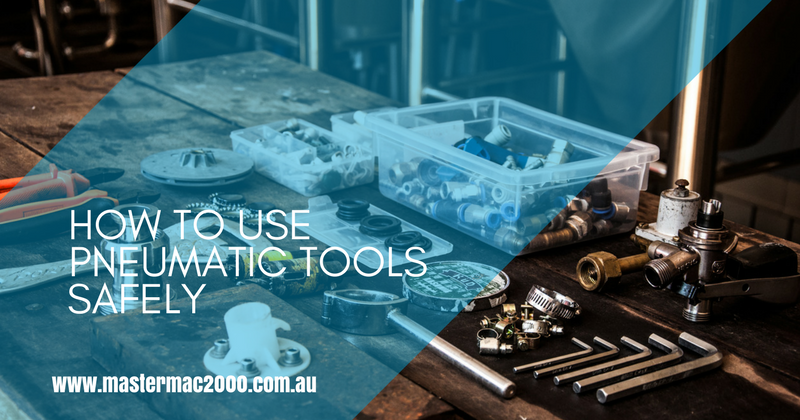How to Use Pneumatic Tools Safely
When working with pneumatic tools, what are the reminders in handling them safely?
Supplied by an air compressor, pneumatic equipment tools are power tools driven by compressed air that is supplied by an air compressor. Carbon dioxide can also be compressed and stored in cylinders to make it portable. Most tools use the pneumatic motor to convert the compressed air to work.
They are also safer compared to electric power tools. They are safer to maintain without high-circuit electrocution and risk of sparks. It is smaller and lighter with a higher power to weight ratio that accomplishes the same tasks. In cases where the tools are overloaded or jammed, they have the less possibility to self-destruct.
Some tools that are cheaper and disposable are called general grade while the ones that are expensive and have long lives are industrial grades.
To avoid any accident in using pneumatic tools, here are the guidelines for safety:
Good condition
Inspect them thoroughly and keep the tools in good operating condition. Pay particular attention to the on and of control valves, guide clips, hose connections, and chunks of reamers.
Manufacturer’s instruction
You should review the manufacturer’s instruction before using the tool for your safety. There might be a feature or additional instruction given in using the said tool.
Personal protective devices
Remember to use pieces of equipment for safety such as goggles or safety glasses, face shields, shoes, boots, and even some hearing protection.
Warning
Post the warning signs where the pneumatic tools are used. The screens and shields should be in the areas where workers nearby may be exposed to chips, excessive noise, dust, or flying fragments. Make sure that prior to opening the valve, no one is standing in the path of the airflow.
Clean
To increase the life of the tool, make sure that the compressed air supplied is clean and dry. Corrosive fumes, dust and moisture can damage the tools. You can also regulate the lubricator and filter to extend the tools life based on the recommendation of the manufacturer. Read this on the manufacturer’s instructions.
Be careful
Make sure that you are vigilant enough to take precautions in keeping your feet, hands, and body from injury in case the tool breaks, or slips. Lay them down in a manner that no harm can be done in case the switch is tripped accidentally. Avoid leaving idle tools in a standing position.
Overworked
Supporting the heavy tools can reduce the fatigue physically. This action counterbalances and aids you from overworking.
The tool
Remember to open the control valve for a moment before connecting the hose the outlet of compressed air. Make sure it is dry and clear from foreign materials.
Make sure that the air hose is suitable for the pressure required for the tool. A defective hose could cause damage. Hoses should not be laid over ladders walkways doorways, or anywhere normally passed by people to avoid tripping hazards.
To avoid accidents, the instructions should be reviewed. Ask for any assistance when you feel uncertain about using any pneumatic tools. It helps to observe first and determine safety precautions than foregoing unexplored skills.

About MasterMac2000: Your Trusted Pneumatic & Process Automation Partner.
LEADING THE INDUSTRY: Established in 1989, MasterMac2000 has grown to become one of Australia's largest privately owned pneumatic and process automation companies. We stock top-quality brands like Univer, Mack, Tolomatic, Mac, Piab, American, and Rotoflux in Brisbane.
SERVING QLD & NORTHERN NSW: We proudly service Queensland and Northern New South Wales for all your pneumatic and process equipment needs. Our mission is to provide the best pre and post-sales support while actively expanding our client base.
SOURCING HARD-TO-FIND PARTS: Not only do we stock quality components, but we also excel at sourcing those elusive, hard-to-find parts. With our extensive database and global network of contacts, getting the parts you require is as easy as a call to our highly skilled, professional sales team.
DEDICATED TO YOUR SUCCESS:
- Decades of expertise in pneumatics & process automation
- Carefully curated selection of world-class brands
- Exceptional sourcing capabilities for speciality parts
- Knowledgeable sales staff dedicated to finding solutions
- Unwavering commitment to customer service excellence
About The Author
Stuart Havill
Stuart Havill is the owner and manager of MasterMac2000, Queensland's largest privately owned pneumatic and process valve company.
With his early working career as a maintenance fitter for Boral in 1992, Stuart has spent his life in the field of pneumatics and process equipment. He gained extensive experience in plant design, maintenance, repairs, fabrication, and site management.
In 1996, he transitioned to a pneumatic sales technician role at MasterMac2000, where he excelled in key account management, providing cost-effective solutions, and managing a sales team of 9 employees.
Since 2002, Stuart has been the manager at MasterMac2000, overseeing the company's growth and establishing it as a leader in pneumatic automation and process valve engineering. His expertise spans customer training, CRM setup, industrial compressor sizing and installation, and turn-key project management.
Under Stuart's leadership, MasterMac2000 has been servicing the industry since 1988, with 5 full-time sales representatives covering northern rivers NSW, Queensland, Northern Territory, and PNG. The company prides itself on providing the best-priced solutions to all customers in the marketplace.
View Stuart’s LinkedIn profile to learn more about his expertise in pneumatics and process equipment.
